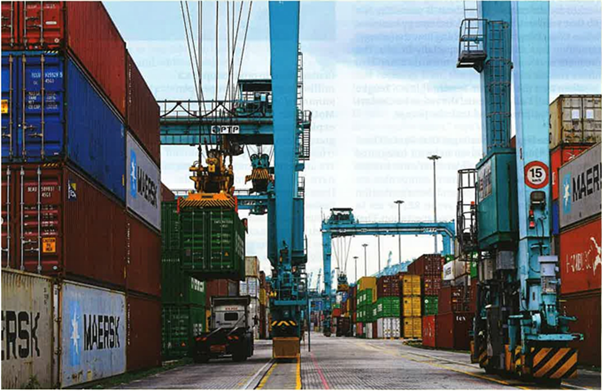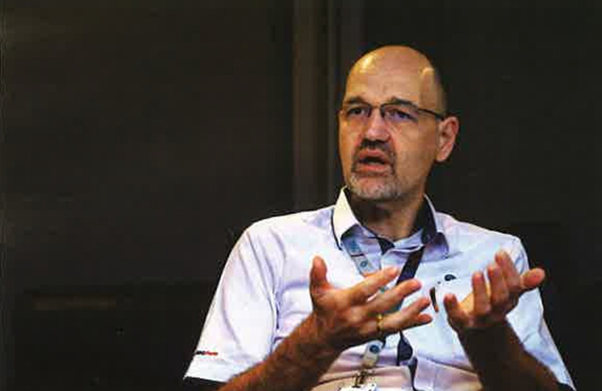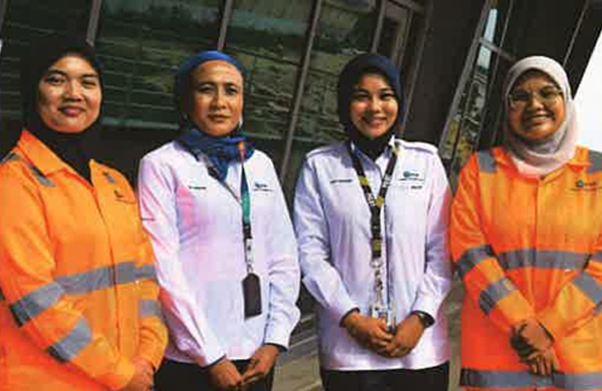Tanjung Pelepas Wants To Get Ahead With ESG
The Edge Malaysia
View Source 
The balcony of the Port of Tanjung Pelepas (PTP) offers a 1800 view of its long berth, lined With towering cranes, stacks Of containers and massive ships passing through the channel.
At the corner of the visitor's eye, however, is the sight of a formidable competitor: Singapore's Tuas Port, which is primed to become the world's largest automated container port in the 2040s.
Already, Johor is suffering from brain drain as workers flock to Singapore due to its stronger currency. For PTP — one of the world's top 20 busiest ports — to stay ahead of the curve,it must do something different.
The port, which is 70% owned by MMC Corp Bhd and the rest by global ports group APM Terminals, reckons it has. The company has embarked on multiple transformation strategies, including sustainability and digitalisation, and has set a goal to reduce 45% of its emissions by 2030.
It has electrified and digitalised many of its assets, resulting in emissions reduction, increased efficiency and less waste, according to the company. For instance, it will electrify all its rubber tyred gantry (RTG) cranes — mobile cranes that stack and transport containers — and yard by the end of this year. This effort began in 2011 and it has already shaved 30% off of its carbon emissions in 2021 compared with its 2011 baseline.
Meanwhile, studies are being done to turn PTP into a green bunkering hub for alternative fuels. This is meant to attract shipping companies that are converting their ships to use green methanol, which is more sustainable.
Interestingly, the company is also investing in and retaining its female workforce in a traditionally male-dominated industry. In fact, the first female marine harbour pilot in Malaysia currently works at PTP (see box story).
"Our customer base, which are the shipping lines, forwarders, warehouses and their customers, have different demands than they had 10 years ago. Therefore, this is part of our transformation journey. It has been requested by the customers, whose children are asking questions [about how sustainable their products are]. The logistics [industry] has to adapt to it," says Marco Neelsen, CEO of PTP.
Electrifying and digitalising its assets is one of PEP's key strategies. Apart from converting the RTGs from using diesel fuel to being powered by electricity, the port is now testing electric prime movers, which are the trucks that move containers, and electric or hybrid fuel tugs and pilot boats.
PTP's digital transformation also involves tracking its assets to create a digital twin and calculating optimal routes for its trucks and boats to save on fuel. This contributes to its sustainability transformation.
"Digitalisation, operational efficiency and sustainability are all moving as one transformation activity. It's something that we can see having a positive impact. Rather than working on your own, we do the transformation together," says Khairul Amalin Abd Rahman, Senior General Manager at PTP.
All this costs money. But Neelsen believes it makes business sense. Rising fuel prices and carbon taxes will be costly to those who do not transition.
"There will be an extra cost in the future, so we need to start incorporating it," he says.
The demands from new consumers who want companies to be more sustainable and new workers who want to work for impactful companies must also be considered, Neelsen says. “These are the questions I get today from young engineers and technology people”.

DIVERSIFYING ITS WORKFORCE
This is also the impetus behind PTP’s drive to recruit and retain female talent.
“At first, we were asked if this was corporate social responsibility. We said no, it’s an economic necessity. We are competing with Singapore for talent. From an economic point of view, why should I exclude 50% of the potential workforce because of gender? We have an issue finding enough people because we have been growing.
Recruiting is in one thing; retaining female talent in a male-dominated industry is another. PTP has had to run focus groups with its female employees to understand how they can make the port a safer workplace, Neelsen says. This includes considering how they can support pregnant female colleagues.
Currently, 8% of the company workforces are women, most of them are in administration.
“We listen and hear what they need to feel safe 24/7 in the terminal. Not only now but also on a Saturday night when it rains and there are 60 females amid 800 males working in the port, for example. Do they have a proper prayer room, washroom and enough light so they are few dark corners?”
Consequently, the firm has had a lower attrition rate among female employees than males, according to Neelsen. The men tend to be attracted by the higher salaries in Singapore. “But for the women, it’s also about the pride of being in this environment because they wouldn’t have imagined that they could do a technical job here where they are supported ... This is an investment that pays off."
He emphasises, however, that equality is still the priority. Those who misbehave or fail to perform, regardless of gender, will not be promoted. The female workforce must not be "ring-fenced" and they have the same rights and obligations as their male colleagues, Neelsen says.
"That has [helped this initiative] gain acceptance in the terminal. A lot of the guys working here have spent 20 years in the port and they are now in their 40s or 50s.They have had a very traditional upbringing. Then, suddenly, there's a girl popping up and driving trucks. In the beginning, they were like, 'No way!”
The first generation of female employees found it tough. "But they pushed through and now it's normalised."
ELECTRIFICATION JOURNEY IS NOT COMPLETE
Much like other industries, energy is PTP's biggest source of emissions. By electrifying its assets, the demand for electricity will rise, which also generates carbon emissions. This is especially true as Malaysia's grid is still primarily powered by fossil fuels.
According to PTP, the net effect is still a reduction in emissions due to the lower emissions factor for electricity generation. Neelsen says the strategy is to do whatever is first within their control, so they can be ready when the grid is greener. But it is also exploring alternative energy sources. For instance, PTP is now in discussion with Malakoff Corp Bhd to build a solar farm.
"With the limitation [of what we can do] with our Scope 2 emissions [from electricity consumption], we need to find sources of green energy… We currently recycle 60% of our waste, and when we looked at our data, we realised we produce a significant amount of organic waste. We have engaged an organisation to see if it can help us convert it into energy, either through the biogas or incineration processes," says Khairul.
The electrification journey for PTP is also not finished. The company is testing out electric prime movers, which are made by Dutch company Terberg Tractors Malaysia Sdn Bhd, in Johor.
The question we need to answer is how to charge. Should it be by changing batteries? Or plugged in? How long will it take? Can we get the same result as with diesel trucks? We have 500 trucks. We need to see whether our electrical network can charge these vehicles," he says.
Another technology that PTP is trialling is the autonomous electric prime mover, which is done in collaboration with several tech companies in Malaysia.
TACKLING THE DIRTY SHIPPING INDUSTRY
The shipping industry is responsible for 2% of global emissions, according to the International Energy Agency, thanks to the heavy fuel oil that it uses. There is huge pressure on the industry to change. One can already See massive container ships fuelled by natural gas docked at Malaysian ports.
"But that only reduces emissions by up to 15% because it's still a fossil fuel. That is why we need to look for completely different fuels. At the moment, studies are focused on using methanol as a replacement. Shipping lines globally have already ordered vessels capable of using methanol," says Neelsen.
Shipping giant AP Moller-Maersk, for instance, has ordered 19 vessels with dual-fuel engines that are able to operate on green methanol and has committed to only ordering vessels that can be operated on green fuels.
Most methanol is now produced from fossil fuels. But green methanol is produced from biomass, such as agriculture residue, or from carbon dioxide and hydrogen generated from renewable energy. It is very expensive at the moment but it is seen as the key transition fuel for the shipping industry.
Neelsen believes that Malaysia is in a good position to produce and store methanol for the shipping industry.
"Traditionally, Singapore is the bunker hub for crude oil ... The shipping community will switch to methanol and Singapore, by its own admission, has said it has a problem. It wants to become the No 1 bunker hub in the world. But it's difficult because methanol cannot be produced in Singapore due to a lack of space," says Neelsen.
In contrast, Malaysia has a large land mass and can store and produce methanol. "That means we have an opportunity to establish Malaysia as an alternative fuel hub to Singapore. With this,we may have a competitive advantage," he says.
That's why the company has engaged in a study with the Australian government to identify alternative fuels for the shipping industry. It is also representing Malaysia in a study with the International Maritime Organisation Norway GreenVoyage2050 Project to look at alternative fuels for tug and pilot boats.
GETTING WOMEN TNTO THE PORT

Captain Nurul Arrienne Mohd Yusoff is a striking figure in the Port of Tanjung Pelepas (PTP). The slender lady, wearing a headscarf and full pilot’s uniform, moves confidently on and off boats in the port. Her responsibility is to hop on the massive container ships when they enter the port and steer the ships to berth.
She’s a rare sight. Nurul Arrienne is the first female marine harbour pilot in Malaysia, according to the company, and now one of two female pilots among 45 men in PTP.
“PTP is the only port that gave me this opportunity to be a marine harbour pilot. As a result, I’m breaking the glass ceiling,” she says.
Nurul Arrienne has been in the industry for over a decade.” After I graduated from the academy [Akademi Laut Malaysia], I sailed as a seafarer. I spent six months on board ships, and I would be one of two-or sometimes the only one – females among 50 men, “she says.
“The challenge is gaining trust from the master of the ship (who actually is a foreigner). When I first started, the masters were quite sceptical. Once, the master asked to see my licence. But after I executed my task safely and met them a few more times, the became more comfortable with me.”
PTP is hoping to train more female pilots, but it difficult. “Many of my batchmates [from the academy] are already settling down,” says Nurul Arrienne.
This is a challenge that PTP will have to grapple with as it hopes to achieve 30% women in management roles by 2025.
It has already made some headway. It has 10% female prime mover operators who move massive container every day, and it has Malaysia’ first female rubber tyred gantry (RTG) crane operator. Nurul Farhana Madani, according to the company. The RTG’s have to be driven by a trained operator, who sits in a cabin on top of the crane. RTG’s can lift containers of up to 61 tonnes and stack them up to 18 metres high.
“I was driving the prime mover before this. Mostly we work with men. The work is the same, but we face some challenges, like going to the restroom. Everyone is really supportive,” says Nurul Farhana.
They take pride in working in this kind of environment, especially in proving to others that they can do this job as well. Nur Athira Huda Mohd Puah, for instance, joined PTP as part of a young engineers programmed and was absorbed as a staff member over three years ago. She strongly believes that men and women complement each other due to their respective strengths.
My seniors never heard of a woman working at a port. It’s the first time, “says Nur Athira.
What made the environment feel safer? Facilities for women and an emphasis on zero tolerance for sexual harassment, observes Siti Halimah Mohamed, one of the prime mover operators
Despite all this, more can be done to support women in the company, and the interviewees were not shy about expressing their demands. A mentorship and coaching programme for women should be established, suggests Dr Irwana Abd Malek, Head of the Supply Chain Division.
“We have to mentor them because they need someone to look up to and obtain advice from. To attract more females to a male-dominated industry, we really need this and a female support group. When we share our success stories as female leaders, we encourage other women to sustain themselves in this industry. Otherwise, talents like Athira, who is still young, might find another good job outside,” says Irwana.
Another suggestion that they had was to establish a childcare centre so that women could continue to work after they gave birth.
“We work by shifts, so it’s quite challenging for people who have children. Nobody wants to take care of our children at night,” says Nurul Farhana.
Arrienne agrees. I’m pregnant right now. I’m hoping there is a day care so that after I deliver, I can go back to piloting the ships. If not, I’ll have to see what happens.”